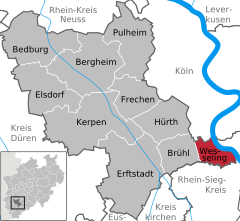Wesseling
| Wesseling | ||
|---|---|---|
| ||
 Wesseling | ||
Location of Wesseling within Rhein-Erft-Kreis district 
 | ||
| Coordinates: 50°49′N 6°58′E / 50.817°N 6.967°ECoordinates: 50°49′N 6°58′E / 50.817°N 6.967°E | ||
| Country | Germany | |
| State | North Rhine-Westphalia | |
| Admin. region | Cologne | |
| District | Rhein-Erft-Kreis | |
| Government | ||
| • Mayor | Erwin Esser (SPD) | |
| Area | ||
| • Total | 23.4 km2 (9.0 sq mi) | |
| Population (2015-12-31)[1] | ||
| • Total | 35,975 | |
| • Density | 1,500/km2 (4,000/sq mi) | |
| Time zone | CET/CEST (UTC+1/+2) | |
| Postal codes | 50389 | |
| Dialling codes | 02236, 02232 | |
| Vehicle registration | BM | |
| Website | www.wesseling.de | |

Chemical industries of Wesseling on the Rhine
Wesseling is an industrial German city on the Rhine bordering Cologne city on the south. Wesseling originates from the Latin "Wasliacum" which means "Village of Waslica" The story that Wesselig originates from "changing of the rope" (German: Cologne-bred:Wechsel de Ling from when Rhine boats were pulled by horses is something like an urban legend because the name Wesseling is centuries older than the horse-changing station, which was located in Wesseling in the 18th century. In addition to 4 subdivisions, Wesseling has the industrial areas "Rheinbogen" and "Eichholz". Home to several chemical companies including Evonik, and Basell, and a Royal Dutch Shell oil refinery; the city was a bombing target of the Oil Campaign of World War II.
| District | Population (Total: 36.729) |
Area [m²] (Total: 23.373.148) |
|---|---|---|
| Wesseling-Mitte | 12.409 | 7.787.685 |
| Keldenich | 15.000 | 5.535.832 |
| Berzdorf | 4.869 | 4.293.268 |
| Urfeld | 4.057 | 5.756.363 |
References
- ↑ "Amtliche Bevölkerungszahlen". Landesbetrieb Information und Technik NRW (in German). 18 July 2016.
This article is issued from Wikipedia - version of the 12/20/2015. The text is available under the Creative Commons Attribution/Share Alike but additional terms may apply for the media files.
